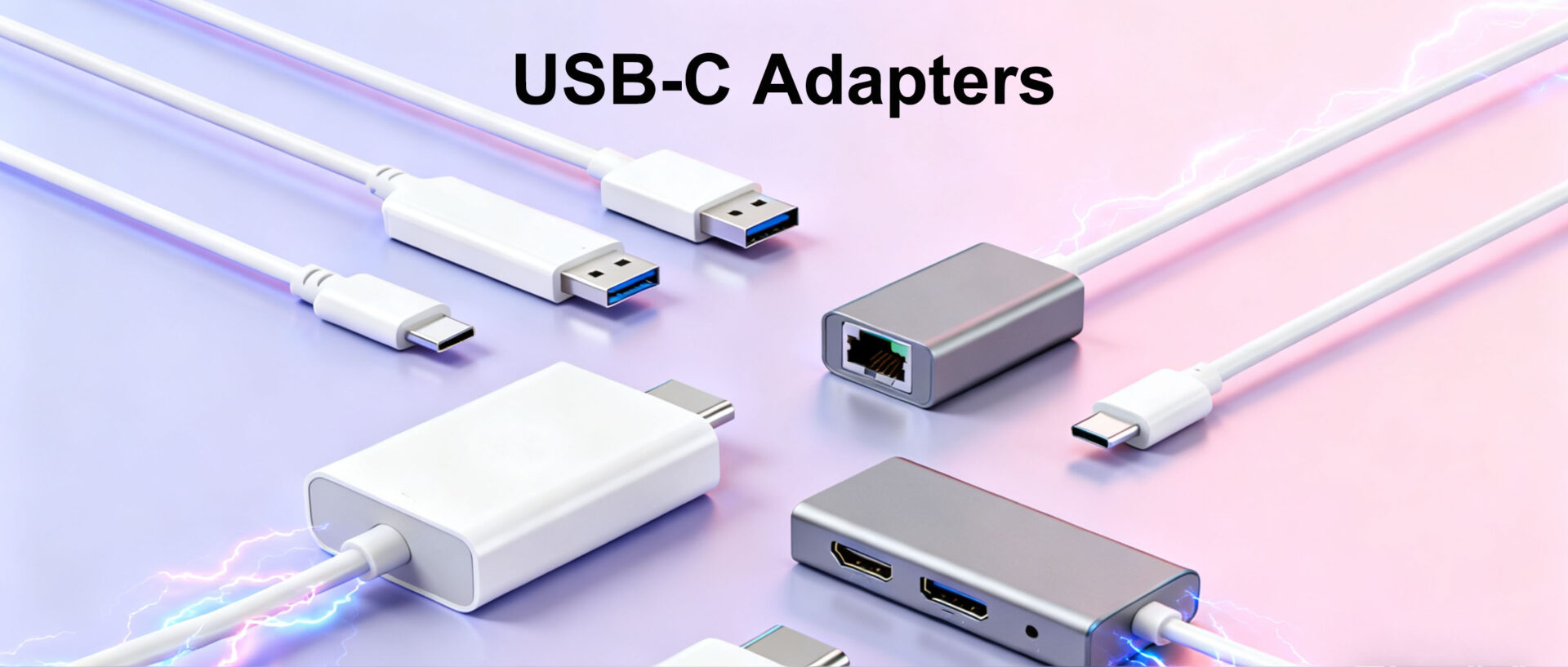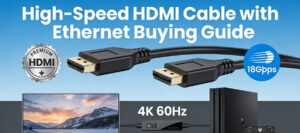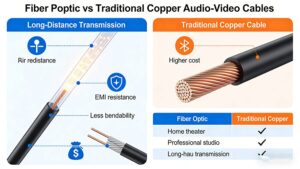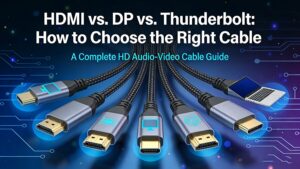En una era en la que los portátiles, teléfonos y tabletas dan prioridad a los diseños delgados frente a los puertos pesados, los adaptadores USB-C se han convertido en los héroes anónimos de la conectividad. Estas herramientas compactas tienden un puente entre los dispositivos USB-C modernos y los periféricos heredados, permitiendo la carga, la transferencia de datos y la salida de vídeo, todo con un solo enchufe. Veamos todo lo que necesitas saber para elegir, usar y solucionar problemas con adaptadores USB-C como un profesional.
¿Qué son los adaptadores USB-C y por qué necesitas uno?
Los adaptadores USB-C (o Tipo-C) convierten la versátil interfaz USB-C en otros tipos de puerto, solucionando los quebraderos de cabeza de la compatibilidad. A diferencia del USB-A tradicional, el USB-C ofrece.
Taponamiento reversible: Se acabaron los problemas para insertar los cables.
Alto rendimiento: Admite velocidades de datos de hasta 10 Gbps (USB 3.2 Gen 2) y carga de hasta 100 W mediante USB-PD (Power Delivery) .
Multifuncionalidad: Transmite simultáneamente señales de datos, alimentación y vídeo/audio.
Cuando lo necesites: Conectar una memoria USB-A al MacBook, conectar el teléfono a un monitor HDMI o cargar el iPhone con un cargador USB-C para portátil.
Los tipos de adaptadores USB-C esenciales (con casos de uso)
No todos los adaptadores son iguales. Adapte el tipo a sus necesidades con esta referencia rápida:
| Tipo de adaptador | Función clave | Lo mejor para | Velocidad/Especificaciones Destacadas |
| USB-C a USB-A | Conecte dispositivos USB-C a periféricos USB-A heredados (ratones, impresoras, etc.). | Usuarios de portátiles con accesorios antiguos | Hasta 10 Gbps (USB 3.2 Gen 2) |
| USB-C a HDMI/Puerto de pantalla | Salida de vídeo 4K desde teléfonos/portátiles a monitores/TV | Trabajadores a distancia, jugadores, presentadores | 4K@60Hz (requiere DisplayPort Alt Mode) |
| Audio de USB-C a 3,5 mm | Conecta auriculares/altavoces con cable a dispositivos sin tomas de audio | Usuarios de teléfonos inteligentes y tabletas | Depende de la calidad del DAC integrado |
| USB-C a Ethernet (RJ45) | Internet por cable estable para portátiles y tabletas delgados | Jugadores, editores de vídeo (baja latencia) | 1 Gbps (con chip Ethernet integrado) |
| USB-C a SD/MicroSD | Leer tarjetas de memoria de cámaras directamente en teléfonos y portátiles | Fotógrafos, creadores de contenidos | Hasta velocidades UHS-II |
| USB-C a Lightning | Carga dispositivos Apple (iPhone/AirPods) a través de puertos USB-C. | Usuarios del ecosistema Apple | Admite carga rápida PD |
Consejo profesional: Para múltiples necesidades (por ejemplo, vídeo + carga + datos), opta por un Concentrador USB-C: muchos incluyen paso PD de 100 W para alimentar el portátil. .
Cómo elegir el adaptador USB-C adecuado (3 pasos fundamentales)
Compruebe primero la compatibilidad
- Especificaciones del dispositivo: Asegúrate de que tu puerto USB-C admite la función (por ejemplo, la salida de vídeo necesita DisplayPort Alt Mode; la carga rápida requiere USB-PD) .
- Soporte de protocolos: Para la carga, priorice PD (funciona con iPhones, Androids y portátiles). Evite los adaptadores sin etiquetas de protocolo claras .
Priorizar la velocidad y la potencia
- Transferencia de datos: Elija USB 3.2 Gen 2 (10 Gbps)para discos duros externos: USB 2.0 (480 Mbps) es demasiado lento para archivos grandes.
- Cargando: Adapte la potencia a su dispositivo (por ejemplo, 20-30 W para iPhones, 65 W o más para portátiles). Busque un soporte PD de 100 W para mayor versatilidad.
No escatime en calidad
- Cables: Para uso de alta potencia (60W+), elija cables con chips E-Marker para evitar el sobrecalentamiento .
- Evite las imitaciones baratas: A menudo carecen de protección contra sobretensiones y causan problemas de conectividad .
Cómo solucionar los problemas más comunes de los adaptadores USB-C
Incluso los mejores adaptadores tienen problemas. He aquí cómo solucionarlos:
| Problema | Causa | Solución |
| Caídas de conexión | Cable/puerto dañado o mala compatibilidad | 1. Pruebe con otro cable/puerto. 2. Verifique las especificaciones del dispositivo con lsusb (Linux) . |
| Transferencia de datos lenta | Adaptador de baja calidad (sólo USB 2.0) | Sustitúyalo por un adaptador USB 3.2 Gen 2. Desactive el ahorro de energía USB (Linux: Edite /etc/modprobe.d/usb.conf) . |
| La carga es lenta | Potencia inadecuada o sin soporte de DP | Utiliza un adaptador con una potencia ≥ el máximo de tu dispositivo (por ejemplo, 33W para Androids de gama media) . |
| No hay salida de vídeo | El puerto carece de DisplayPort Modo Alt | Consulta el manual de tu dispositivo: algunos puertos USB-C solo admiten carga/datos . |
| Pérdida de datos durante la transferencia | Desconexión repentina o cable defectuoso | Utilizar sistemas de archivos NTFS/ZFS (corrección de errores) y verificar archivos con md5sum . |
Reflexiones finales: Desbloquea toda la conectividad
Los adaptadores USB-C convierten un único puerto en un concentrador de posibilidades, ya sea para trabajar desde una cafetería, editar fotos o transmitir a un televisor. Si te centras en la compatibilidad, la calidad y tus necesidades específicas, evitarás frustraciones y sacarás el máximo partido a tus dispositivos.
¿Cuál es tu mayor reto de conectividad USB-C? Háznoslo saber en los comentarios.







